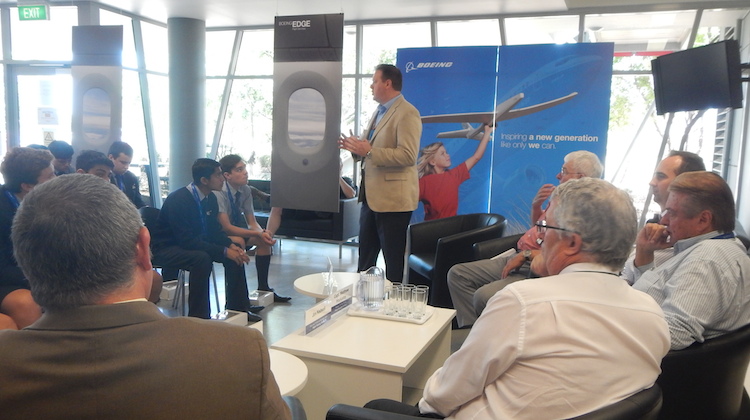Boeing Flight Services has pledged to repeat its Brisbane campus visit in 2015 following the success of inaugural event in 2014.
The teaching and training arm of the manufacturing giant recently hosted 30 high school students at its Brisbane campus, where they spoke with pilots, engineers and technicians from Boeing, Virgin Australia and others.
The Brisbane event followed similar campus visits at Boeing Flight Services’ Miami and Singapore facilities earlier in 2014.
Boeing Flight Services’ pilot development program manager David Wright said the campus visits were part of the company’s efforts to promote a career in the aviation industry, given the expected demand for pilots and technicians in the decades ahead as more people travel.
“I can tell you that it has been a very, very successful launch to the program to the point where we’ve committed to doing this again next year,” Wright said in an interview with Australian Aviation.
“The calibre of students that I met when I was down there was phenomenal.
“These cadets were engaged, the questions they asked were very forward looking. The maturity level within the aviation profession that they were at was impressive.”
The need to attract pilots and other aviation professionals becomes apparent when you look at forecasts from both Boeing and Toulouse-based rival Airbus on the number of new aircraft airlines were expected to order in the coming two decades.
Based on those figures, Boeing’s Pilot and Technician outlook expects 533,000 new pilots and 584,000 new maintenance technicians will have to be found between now and 2033.
The demand is particularly acute in the Asia Pacific region, which is tipped to need 216,000 new pilots and 224,000 technicians in that time frame.
And as the report highlights, it is not just pilots but all manner of jobs related to getting aircraft ready and safe to fly.
“Our goal is to shine a light on the whole industry,” Wright said.
“If you want to be a pilot now is the time to start to do it but this also an industry that is going to be sustainable for at least 25 to 30 years, a strong, growing vibrant industry which will lead to growth in every area – engineering, operations, management.”
In addition to Boeing Flight Services’ Australian campuses in Brisbane and Melbourne, there were other Australian training centres playing their role in developing those new pilots and technicians.
Guangzhou-based China Southern has a pilot training school at Perth’s Jandakot Airport, while Cathay Pacific and its regional wing Dragonair has been sending prospective pilots to Flight Training Adelaide for many years.
Wright said it was a very competitive global marketplace for talented workers and those in the aviation industry needed to ensure their training programs and career pathways were competitive with other sectors.
“This generation globally is more at home interacting with a system and monitoring a system than probably any other generation that we have looked at training,” Wright said.
“No matter what is going on in the marketplace I think that the industry needs to realise there is real opportunity to try to pull from that type of student and leverage that into the technology that is being put into the aircraft.”
Australia’s newest airport has also linked up with the Airline Academy of Australia (AAA) and University of Southern Queensland (USQ) for a new aviation education precinct.
The school will offer pilot training as well as courses for aircraft maintenance, engineering and electronics.
While the AAA will run the pilot courses with light aircraft permanently on site at the airport, USQ will conduct the other training courses.
That competition for pilots and skilled aviation technicians was only expected to grow in the years ahead as airlines added more aircraft to their fleets and scheduled more flights in line with the anticipated demand for air travel.
“Meeting this exponential increase in demand will require innovative solutions-focused on new, digital technology-to match the learning requirements of a new generation,” the Boeing pilot and technician outlook report said.
“The growing diversity of aviation personnel will also require instructors to have cross-cultural and cross-generational skills in order to engage tomorrow’s workforce.”

















